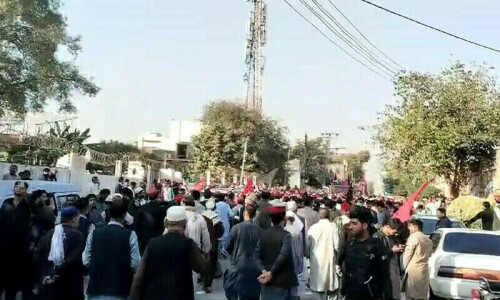KOHAT, April 8: Increasing congestion in Kohat has created an urgent need for planned public sector housing and commercial schemes along the four highways around the city.
The nearest towns are several miles away from Kohat and the land in between is uninhabited which may be developed and used to meet growing demands of residential and commercial units, shows a survey.
The areas along the Indus Highway — from Rawalpindi to the Friendship tunnel towards north; up to the Lachi town; about 7km towards West, and 5km in the East are lying unutilized.
These pieces of land are also usable because they are barren for want of irrigation water. These can be developed into residential schemes meant mainly for those with limited income.
The Kohat city, stretching to a small area of 5 square-kilometres for decades, did not expand due to its proximity to tribal areas and B-areas. Thousands of push-carts, dozens of bazaars and shopping plazas and private and government offices within this short space has made Kohat polluted. Encroachments have added to congestion.
A house which catered to the needs of two families 20 years back has now become insufficient as the number of family members has grown. People have started constructing second and third storeys on old houses which has deprived the inhabitants of fresh air and sunlight.
In order to meet the ever-increasing cost of living, most people have converted ground floors of their houses into shops though municipality rules prohibit construction of shops and markets in residential areas. As a result, streets remain littered with construction material every now and then.
The last attempt to expand the city was made in 1979 when the Kohat Development Authority (KDA) was set up. In 1982, the authority flattened a hill and converted it into a township which became the NWFP’s most beautiful housing scheme attracting people from other districts and adjoining tribal areas besides creating an economic activity in the area.
The KDA then launched a second phase of the scheme. Now these phases are considered posh localities and the price of land has gone up manifold over the past three to four years making it impossible for the common man to buy a plot there.
On average, a one-kanal plot in the township costs between Rs500,000 and Rs1.5 million and one would need at least Rs2 million more to build a modest house on it making it unaffordable for the middle class people who still prefer the joint family system. Likewise, the price of a 6 marla plot in phase-I has increased 15 to 20 times as compared to early nineties. However, plots in this size are scarcely available.
The other attractive area is the cantonment where a one-kanal plot costs more than Rs4 million.
The private sector did try to meet the shortage of housing units, but failed to develop the areas according to the needs of people. The prices of these units are affordable but the areas where they are located lack necessities of life like roads and sewerage system. Moreover, these schemes are far from main roads.
The KDA, which earned more than Rs80 million from its lone housing scheme, kept the amount in fixed deposit and the profit thus received is consumed in salaries of its staff. By spending half of this amount, the KDA authorities can develop good housing schemes along the Indus Highway and help lessen the population burden on the city. On the other hand, their savings would also be increased if they considered the proposal.














































Dear visitor, the comments section is undergoing an overhaul and will return soon.